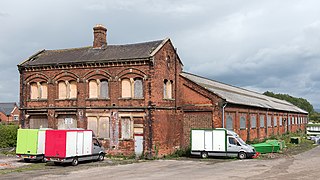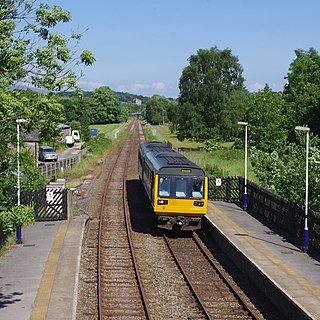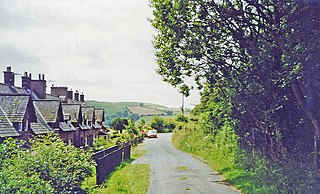Related Research Articles

The Maryport & Carlisle Railway (M&CR) was an English railway company formed in 1836 which built and operated a small but eventually highly profitable railway to connect Maryport and Carlisle in Cumberland, England. There were many small collieries in the area and efficient access to the harbour at Maryport was important.
The North Western Railway (NWR) was an early British railway company in the north-west of England. It was commonly known as the "Little" North Western Railway, to distinguish it from the larger London and North Western Railway (LNWR).

The Lancaster and Carlisle Railway was a main line railway opened between those cities in 1846. With its Scottish counterpart, the Caledonian Railway, the Company launched the first continuous railway connection between the English railway network and the emerging network in central Scotland. The selection of its route was controversial, and strong arguments were put forward in favour of alternatives, in some cases avoiding the steep gradients, or connecting more population centres. Generating financial support for such a long railway was a challenge, and induced the engineer Joseph Locke to make a last-minute change to the route: in the interests of economy and speed of construction, he eliminated a summit tunnel at the expense of steeper gradients.

The Cumbrian Coast line is a rail route in North West England, running from Carlisle to Barrow-in-Furness via Workington and Whitehaven. The line forms part of Network Rail route NW 4033, which continues via Ulverston and Grange-over-Sands to Carnforth, where it connects with the West Coast Main Line.

Kendal railway station is a railway station serving the market town of Kendal in Cumbria, England. The station is owned by Network Rail and is operated by Northern Trains who provide all passenger train services.

Lancaster railway station is a railway station that serves the city of Lancaster in Lancashire, England. It is one of the principal stations on the West Coast Main Line. It is located 20 miles 78 chains (33.76 km) from Preston and is the zero point for mileages onward to Carlisle.

Dalton is a railway station on the Furness Line, which serves the town of Dalton-in-Furness in Cumbria, England. It is owned by Network Rail and managed by Northern Trains.
The Lancaster and Preston Junction Railway opened its twenty-mile line in 1840 in Lancashire, England. The company was not commercially successful. When the Lancaster and Carlisle Railway opened in 1846, the L&PJR became part of a busy trunk railway. It had never had the money to provide substantial track equipment or proper signalling arrangements. Most of the line is in use today as part of the West Coast Main Line railway and has been electrified. None of the L&PJR stations are still in use.

Tebay railway station was situated on the Lancaster and Carlisle Railway (L&CR) between Lancaster and Penrith. It served the village of Tebay, Cumbria, England. The station opened in 1846, and closed on 1 July 1968.

Carlisle London Road railway station was the first to open in Carlisle, Cumbria, England. It was built as a terminus of the Newcastle and Carlisle Railway and opened in 1836, when trains could only run as far as Greenhead; not until 1838 was it possible to travel by rail all the way to Gateshead.

Lancaster Green Ayre railway station was the Midland Railway's station in the city of Lancaster in England. The line between Green Ayre and Morecambe was used for pioneering experimental electrification via overhead wires.

The Leeds–Morecambe line, also known as the Bentham line, is a railway line running between Leeds, Skipton, Lancaster and Morecambe in northern England. The service is operated by Northern. The route covered by the service was historically part of the Midland Railway. The line is electrified at 25 kV AC overhead between Leeds City and Skipton- this section is known as the Airedale line.
Shap railway station served the village of Shap, Westmorland, England for over 120 years.

The first Lancaster railway station was the northern terminus of the Lancaster and Preston Junction Railway, located in the Greaves area of the city of Lancaster, Lancashire, England. It was open from 1840 to 1849, by which time it had been superseded by Lancaster Castle railway station. Some books refer to the station as "Lancaster (Greaves)" or "Lancaster " to distinguish it from later stations in the city, although whilst open it was known simply as "Lancaster" as there was no other station of that name at the same time.
Southwaite railway station in Hesket parish, was situated on the Lancaster and Carlisle Railway between Carlisle and Penrith. It served the village of Southwaite, Cumbria, England. The station opened in 1846, and closed on 7 April 1952.
Plumpton railway station in Hesket parish in what is now Cumbria but was then Cumberland in the north west of England, was situated on the Lancaster and Carlisle Railway between Carlisle and Penrith. It served the village of Plumpton and the surrounding hamlets. The station opened on 17 December 1846, and closed on 31 May 1948.
Brisco railway station (NY4313251259) in St Cuthbert Without parish, was situated on the Lancaster and Carlisle Railway between Carlisle and Penrith. It served the rural district of Brisco and Newbiggin Hall, Cumbria, England. The station opened on 17 December 1846, and closed in December 1852.

Low Gill railway station served the hamlet of Lowgill, Westmorland, England, from 1846 to 1966 on the Lancaster and Carlisle Railway.

Burton and Holme railway station served the village of Burton-in-Kendal, Westmorland, England, from 1846 to 1966 on the Lancaster and Carlisle Railway.

Bolton-le-Sands railway station served the village of Bolton-le-Sands, Lancashire, England, from 1847 to 1969 on the Lancaster and Carlisle Railway.
References
| Preceding station | Historical railways | Following station | ||
|---|---|---|---|---|
| Oxenholme Line and station open | Lancaster and Carlisle Railway | Burton and Holme Line open, station closed | ||